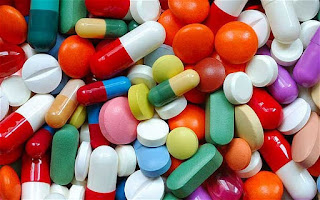Dobutamine hydrochloride
Trade name: Dobutrex
Drug classes:
• Sympathomimetic
• β1-selective adrenergic agonist
Pregnancy: (Category B)
Therapeutic
actions:
Positive
inotropic effects are mediated by β1- adrenergic receptors in the
heart; increases the force of myocardial contraction with relatively minor
effects on heart rate, arrhythmogenesis; has minor effects on blood vessels.
Indications
•
For inotropic support in
the short-term treatment of adults with cardiac decompensation due to depressed
contractility, resulting from either organic heart disease or from cardiac
surgical procedures
• Investigational use in children with congenital heart disease
undergoing diagnostic cardiac catheterization, to augment CV function
Dosage
§ Available Forms: Injection 12.5 mg/mL.
§ Administer only by IV infusion.
§ Titrate on the basis of the patient's homodynamic/renal
response.
§ Close monitoring is necessary.
Adult:
2.5---15
µg/kg/min IV is usual rate to increase cardiac output; rarely, rates up to 40
µg/kg per minute are needed.
IV facts
•
Preparation: Reconstitute by adding
10 mL Sterile Water for Injection or 5% Dextrose Injection to 250-mg vial. If
material is not completely dissolved, add 10 mL of diluent.
Further dilute to at least 50 mL with 5% Dextrose Injection,
0.9% Sodium Chloride
Injection, or Sodium
Lactate Injection. Store reconstituted solution under refrigeration for 48 h or
at room temperature for 6 h. Store final diluted solution in glass or via flex
container at room temperature. Stable for 24 h. Do not freeze. (Note: drug
solutions may exhibit a
color that increases with time; this indicates oxidation of
the drug, not a loss of potency.)
• Infusion:
May be administered through common IV tubing with dopamine,
lidocaine, tobramycin, nitroprusside, potassium chloride, or protamine sulfate.
Titrate rate based on patient response--P, BP, rhythm; use of an infusion pump
is suggested.
• Incompatibilities:
Do not mix drug with
alkaline solutions, such as 5% Sodium Bicarbonate Injection; do not mix with
hydrocortisone sodium succinate, cefazolin, cefamandole, neutral cephalothin,
penicillin, sodium ethacrynate; sodium heparin.
• Y-site
Incompatibilities: Do not mix with acyclovir, alteplase,
aminophylline, foscarnet.
Adverse effects
• CNS: Headache
• GI: Nausea
• CV: Increase in heart rate,
increase in systolic blood pressure, increase in ventricular ectopic beats
(PVCs), anginal pain, palpitations, shortness of breath
Clinically important interactions
• Drug-drug
v Increased effects with TCAs (eg, imipramine), furazolidone,
methyldopa
v Risk of severe hypertension with β-blockers
v Decreased effects of guanethidine with dobutamine
Nursing
Considerations
v Arrange to digitalize patients who have atrial fibrillation with
a rapid ventricular rate before giving dobutamine--dobutamine facilitates AV
conduction.
v Monitor
urine flow, cardiac output, pulmonary wedge pressure, ECG, and BP closely
during infusion; adjust dose/rate accordingly.



